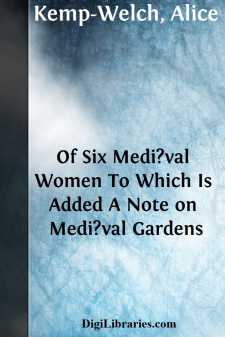Categories
- Antiques & Collectibles 13
- Architecture 36
- Art 48
- Bibles 22
- Biography & Autobiography 813
- Body, Mind & Spirit 142
- Business & Economics 28
- Children's Books 17
- Children's Fiction 14
- Computers 4
- Cooking 94
- Crafts & Hobbies 4
- Drama 346
- Education 46
- Family & Relationships 57
- Fiction 11829
- Games 19
- Gardening 17
- Health & Fitness 34
- History 1377
- House & Home 1
- Humor 147
- Juvenile Fiction 1873
- Juvenile Nonfiction 202
- Language Arts & Disciplines 88
- Law 16
- Literary Collections 686
- Literary Criticism 179
- Mathematics 13
- Medical 41
- Music 40
- Nature 179
- Non-Classifiable 1768
- Performing Arts 7
- Periodicals 1453
- Philosophy 64
- Photography 2
- Poetry 896
- Political Science 203
- Psychology 42
- Reference 154
- Religion 513
- Science 126
- Self-Help 84
- Social Science 81
- Sports & Recreation 34
- Study Aids 3
- Technology & Engineering 59
- Transportation 23
- Travel 463
- True Crime 29
Of Six Medi?val Women To Which Is Added A Note on Medi?val Gardens
by: Alice Kemp-Welch
Description:
Excerpt
INTRODUCTION
The recent researches of scholars and students have brought the study of mediæval times within the range of almost any one who cares to live in imagination in the past. No part of this study has been more advanced and made more informing to us than that which regards the individual. This is specially true of womankind, of whom we have learnt somewhat, in some instances from their own writings, and in others from allusions to their work in those of contemporary and later writers, and also, incidentally, from the vast storehouse of didactic literature, which is so suggestive in itself, reflecting through successive centuries, as it seems to do, the standard of conduct of the large majority. But on this subject—a very large one, and only partially explored—light can only be thrown gradually. For this there are various reasons. One is that, until comparatively recent times, the small details of everyday life which go so largely to make up a woman’s life, have generally been taken for granted by writers. Then the few mediæval historiographers and chroniclers were principally engaged in recounting the deeds of kings and feats of arms. Then again, although probably many MSS. of the time still lie undiscovered in libraries, those that are known to us are scattered far and wide. Furthermore, self-advertisement was not a mediæval fashion. It is perhaps difficult for us nowadays to understand a spirit of self-effacement. Self-esteem, which may develop for either good or ill, has perhaps always existed in the human breast, but certainly since the time of the Renaissance, when it seemed to have its own special revival, it has grown apace, and is to-day like unto the Mustard Tree of Holy Writ. But it is not proposed to contrast this our modern attitude with the impersonal one, if so it may be called, of the Middle Ages, because, whilst there were many humble, zealous workers then, just as there are now, it is possible there were other and perhaps more potent factors to account for this apparently humble attitude. In mediæval days, the subject of a narrative or didactic work was considered so important, that an author would scarcely venture on any independent treatment of a theme for fear of incurring censure for a contempt of authority, or, if he did so venture, he would probably deem it wiser to do so anonymously, or by ascription to some departed celebrity, who was obviously not in a position to gainsay him. The writer was of much less interest than his ideas and sentiments. Then again there was the intense localisation of life. Localities were very independent of one another. Each was complete in itself, and within it there was no need for self-advertisement. It was the same in the wider life of associated religious communities, such as Benedictines, Cluniacs, and Cistercians, who had so much to do with the building of abbeys and cathedrals. Within a fraternity, the specially gifted craftsman was known, and wherever work was going on within the Order, was made use of as needs be, not as Brother This, or Brother That, but simply as scribe, or as artificer in Madonnas or gargoyles, or whatever else was wanted....


